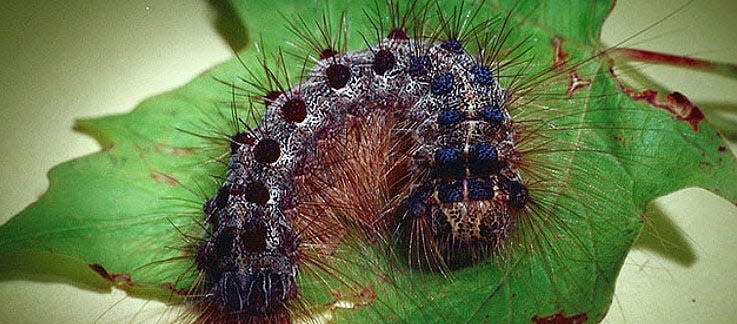Spongy moth: Next invasive species destroying trees and shrubs, and how to kill them
First, it was the spotted lanternfly wreaking havoc and killing trees and shrubbery in Bucks County and throughout Pennsylvania.
Now, there's another invasive species chewing through vast numbers of trees and shrubs in Pennsylvania: the spongy moth.
The spongy moth — which also goes by the scientific name Lymantria dispar dispar and once known as the European gypsy moth — is deemed a hazard, as it defoliates trees, leaving them vulnerable to diseases and other pests, and can eventually kill the tree, according to the U.S. Department of Agriculture's Animal and Plant Health Inspection Service.
The spongy moth has a spongy or hair-like covering, which allows it to survive through the winter months and can be inadvertently transferred to household items and agricultural products.
Delaware, Ohio, New York and New Jersey are also listed as states within the spongy moth quarantine area.
Here's everything else you need to know about this invasive species, including how to eradicate them ahead of spring gardening.
Spongy moth found in Christmas trees, BBQ grills and trash containers
The insect has an insatiable appetite, feeding on more than 300 varieties of trees and shrubs.
The spongy moth particularly favors aspen, birch, cedar, cottonwood, larch, oak, poplar, willow and fruit trees.

Even more alarming, the spongy moth can nest and breed almost anywhere and in nearly every household thing.
The Spooted Lanternfly menace: It's spotted lanternfly season in Pennsylvania. Why they are bad and how to kill them.
The inspection service has long list of where the spongy moth can hide and grow:
Awnings
Bicycles
Boats
Barbecue grills
Christmas trees
Dog houses
Firewood
The spongy moth can also be found in and transported by garbage containers, garden tools, household items stored outside, logs, mobile homes, nursery stock, outdoor furniture, pulpwood, recreational vehicles, trailers, tires, tents and wood chips.
How to safely remove wasp nests: How to get rid of wasp nests this summer, and what to do if you try viral TikTok trend
How to identify a spongy moth outbreak
Since 1970, spongy moths have defoliated more than 75 million acres in the United States, and the telltale signs are hard to miss, once you know what to look for.
There are four general signs of a spongy moth outbreak, according to the inspection service:
Visible egg masses: covered with buff or yellowish hair from the female and averages about 1-1/2 inches long and about 3/4 of an inch wide. Adult female moths lay egg masses on any type of surface, including trees and agricultural products, household furniture, and other items.
Visible caterpillars: newly hatched caterpillars are black and hairy. Later stages of the larvae develop a mottled yellow to gray pattern with tufts of bristle-like hairs and a distinctive color pattern of five pairs of blue dots followed by six pairs of red dots along their backs.
Visible adult moths: male moths are brown with a darker brown pattern on their wings and have a 1-1/2-inch wingspan. Females are slightly larger, with a two-inch wingspan, and nearly white with dark saw-toothed patterns on their wings. Male spongy moth adults can fly but female spongy moth adults do not have flight capability.
Defoliated trees.
How to get rid of spongy moths on your property
The inspection service suggests residents remove and destroy any spongy moth nests they find, and to report findings of egg masses on trees, lawn furniture, fences, walls or elsewhere on private property online through a self-certification process.
There are several ways to rid one's property of spongy moths.
Planet Natural Resource Center suggests using moth traps, pest barriers and garden insect sprays.
"Maximum treatment effectiveness is achieved by targeting caterpillars at a specific developmental stage, a period known as the treatment window, which generally occurs in May," read a statement from the Pennsylvania Department of Conservation and Natural Resources. "The finite number of available applicators coupled with a relatively short period of treatment effectiveness makes early planning crucial to securing treatment services in the spring.
"Product formulations, Bacillus thuringiensis kurstaki and Mimic, used on state lands are effective and safe."
This article originally appeared on Bucks County Courier Times: Spongy moth outbreak in Pennsylvania destructive to trees

